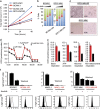Waldenstrom macroglobulinemia cells devoid of BTKC481S or CXCR4WHIM-like mutations acquire resistance to ibrutinib through upregulation of Bcl-2 and AKT resulting in vulnerability towards venetoclax or MK2206 treatment
- PMID: 28548645
- PMCID: PMC5518884
- DOI: 10.1038/bcj.2017.40
Waldenstrom macroglobulinemia cells devoid of BTKC481S or CXCR4WHIM-like mutations acquire resistance to ibrutinib through upregulation of Bcl-2 and AKT resulting in vulnerability towards venetoclax or MK2206 treatment
Abstract
Although ibrutinib is highly effective in Waldenstrom macroglobulinemia (WM), no complete remissions in WM patients treated with ibrutinib have been reported to date. Moreover, ibrutinib-resistant disease is being steadily reported and is associated with dismal clinical outcome (overall survival of 2.9-3.1 months). To understand mechanisms of ibrutinib resistance in WM, we established ibrutinib-resistant in vitro models using validated WM cell lines. Characterization of these models revealed the absence of BTKC481S and CXCR4WHIM-like mutations. BTK-mediated signaling was found to be highly attenuated accompanied by a shift in PI3K/AKT and apoptosis regulation-associated genes/proteins. Cytotoxicity studies using the AKT inhibitor, MK2206±ibrutinib, and the Bcl-2-specific inhibitor, venetoclax±ibrutinib, demonstrated synergistic loss of cell viability when either MK22016 or venetoclax were used in combination with ibrutinib. Our findings demonstrate that induction of ibrutinib resistance in WM cells can arise independent of BTKC481S and CXCR4WHIM-like mutations and sustained pressure from ibrutinib appears to activate compensatory AKT signaling as well as reshuffling of Bcl-2 family proteins for maintenance of cell survival. Combination treatment demonstrated greater (and synergistic) antitumor effect and provides rationale for development of therapeutic strategies encompassing venetoclax+ibrutinib or PI3K/AKT inhibitors+ibrutinib in ibrutinib-resistant WM.
Conflict of interest statement
The authors declare no conflict of interest.
Figures






Similar articles
-
The BCL2 antagonist ABT-199 triggers apoptosis, and augments ibrutinib and idelalisib mediated cytotoxicity in CXCR4 Wild-type and CXCR4 WHIM mutated Waldenstrom macroglobulinaemia cells.Br J Haematol. 2015 Jul;170(1):134-8. doi: 10.1111/bjh.13278. Epub 2015 Jan 12. Br J Haematol. 2015. PMID: 25582069 No abstract available.
-
The WHIM-like CXCR4(S338X) somatic mutation activates AKT and ERK, and promotes resistance to ibrutinib and other agents used in the treatment of Waldenstrom's Macroglobulinemia.Leukemia. 2015 Jan;29(1):169-76. doi: 10.1038/leu.2014.187. Epub 2014 Jun 10. Leukemia. 2015. PMID: 24912431
-
CXCR4 WHIM-like frameshift and nonsense mutations promote ibrutinib resistance but do not supplant MYD88(L265P) -directed survival signalling in Waldenström macroglobulinaemia cells.Br J Haematol. 2015 Mar;168(5):701-7. doi: 10.1111/bjh.13200. Epub 2014 Nov 5. Br J Haematol. 2015. PMID: 25371371
-
Ibrutinib for the treatment of Waldenström macroglobulinemia.Expert Rev Hematol. 2015 Oct;8(5):569-79. doi: 10.1586/17474086.2015.1061427. Epub 2015 Jul 2. Expert Rev Hematol. 2015. PMID: 26138997 Review.
-
Future therapeutic options for patients with Waldenström macroglobulinemia.Best Pract Res Clin Haematol. 2016 Jun;29(2):206-215. doi: 10.1016/j.beha.2016.08.021. Epub 2016 Sep 14. Best Pract Res Clin Haematol. 2016. PMID: 27825467 Review.
Cited by
-
Aberrant CXCR4 Signaling at Crossroad of WHIM Syndrome and Waldenstrom's Macroglobulinemia.Int J Mol Sci. 2020 Aug 8;21(16):5696. doi: 10.3390/ijms21165696. Int J Mol Sci. 2020. PMID: 32784523 Free PMC article. Review.
-
Waldenstrom Macroglobulinemia: Tailoring Therapy for the Individual.J Clin Oncol. 2022 Aug 10;40(23):2600-2608. doi: 10.1200/JCO.22.00495. Epub 2022 Jun 14. J Clin Oncol. 2022. PMID: 35700418 Free PMC article. Review.
-
Inhibiting Bruton's Tyrosine Kinase in CLL and Other B-Cell Malignancies.Target Oncol. 2019 Apr;14(2):125-138. doi: 10.1007/s11523-019-00635-7. Target Oncol. 2019. PMID: 30927175 Review.
-
Determinants of Drug Resistance in B-Cell Non-Hodgkin Lymphomas: The Case of Lymphoplasmacytic Lymphoma/Waldenström Macroglobulinemia.Front Oncol. 2022 Jan 11;11:801124. doi: 10.3389/fonc.2021.801124. eCollection 2021. Front Oncol. 2022. PMID: 35087759 Free PMC article. Review.
-
A Virtual Screening Platform Identifies Chloroethylagelastatin A as a Potential Ribosomal Inhibitor.Biomolecules. 2020 Oct 5;10(10):1407. doi: 10.3390/biom10101407. Biomolecules. 2020. PMID: 33027969 Free PMC article.
References
-
- Owen RG, Treon SP, Al-Katib A, Fonseca R, Greipp PR, McMaster ML et al. Clinicopathological definition of Waldenstrom's macroglobulinemia: consensus panel recommendations from the Second International Workshop on Waldenstrom's macroglobulinemia. Semin Oncol 2003; 30: 110–115. - PubMed
-
- Treon SP, Tripsas CK, Meid K, Warren D, Varma G, Green R et al. Ibrutinib in previously treated Waldenstrom's macroglobulinemia. N Engl J Med 2015; 372: 1430–1440. - PubMed
-
- Cao Y, Hunter ZR, Liu X, Xu L, Yang G, Chen J et al. The WHIM-like CXCR4(S338X) somatic mutation activates AKT and ERK, and promotes resistance to ibrutinib and other agents used in the treatment of Waldenstrom's macroglobulinemia. Leukemia 2015; 29: 169–176. - PubMed
MeSH terms
Substances
Grants and funding
LinkOut - more resources
Full Text Sources
Other Literature Sources
Molecular Biology Databases
Research Materials

